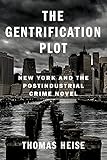The Gentrification Plot : New York and the Postindustrial Crime Novel / / Thomas Heise.
Material type: TextSeries: Literature NowPublisher: New York, NY : : Columbia University Press, [2021]Copyright date: ©2021Description: 1 online resourceContent type:
TextSeries: Literature NowPublisher: New York, NY : : Columbia University Press, [2021]Copyright date: ©2021Description: 1 online resourceContent type: - 9780231553483
- 813/.0872093587471043 23
- PS374.D4 H45 2022
- PS374.D4
- online - DeGruyter
| Item type | Current library | Call number | URL | Status | Notes | Barcode | |
|---|---|---|---|---|---|---|---|
 eBook
eBook
|
Biblioteca "Angelicum" Pont. Univ. S.Tommaso d'Aquino Nuvola online | online - DeGruyter (Browse shelf(Opens below)) | Online access | Not for loan (Accesso limitato) | Accesso per gli utenti autorizzati / Access for authorized users | (dgr)9780231553483 |
Browsing Biblioteca "Angelicum" Pont. Univ. S.Tommaso d'Aquino shelves, Shelving location: Nuvola online Close shelf browser (Hides shelf browser)
Frontmatter -- CONTENTS -- Introduction. Death and Life in Postindustrial New York -- Chapter One. The Lower East Side: Cops, Culture, and the Creative Class -- Chapter Two. Chinatown: Policing the Ethnic Enclave -- Chapter Three. Red Hook: Blood on the Industrial Waterfront -- Chapter Four. Harlem: Uptown Dead Zones -- Chapter Five. Bedford- Stuyvesant: White Boys in the Hood -- Epilogue. Escape from New York -- ACKNOWLEDGMENTS -- NOTES -- BIBLIOGRAPHY -- INDEX
restricted access online access with authorization star
http://purl.org/coar/access_right/c_16ec
For decades, crime novelists have set their stories in New York City, a place long famed for decay, danger, and intrigue. What happens when the mean streets of the city are no longer quite so mean? In the wake of an unprecedented drop in crime in the 1990s and the real-estate development boom in the early 2000s, a new suspect is on the scene: gentrification. Thomas Heise identifies and investigates the emerging "gentrification plot" in contemporary crime fiction. He considers recent novels that depict the sweeping transformations of five iconic neighborhoods-the Lower East Side, Chinatown, Red Hook, Harlem, and Bedford-Stuyvesant-that have been central to African American, Latinx, immigrant, and blue-collar life in the city. Heise reads works by Richard Price, Henry Chang, Gabriel Cohen, Reggie Nadelson, Ivy Pochoda, Grace Edwards, Ernesto Quiñonez, Wil Medearis, and Brian Platzer, tracking their representations of "broken-windows" policing, cultural erasure, racial conflict, class grievance, and displacement. Placing their novels in conversation with oral histories, urban planning, and policing theory, he explores crime fiction's contradictory and ambivalent portrayals of the postindustrial city's dizzying metamorphoses while underscoring the material conditions of the genre. A timely and powerful book, The Gentrification Plot reveals how today's crime writers narrate the death-or murder-of a place and a way of life.
Mode of access: Internet via World Wide Web.
In English.
Description based on online resource; title from PDF title page (publisher's Web site, viewed 18. Sep 2023)









